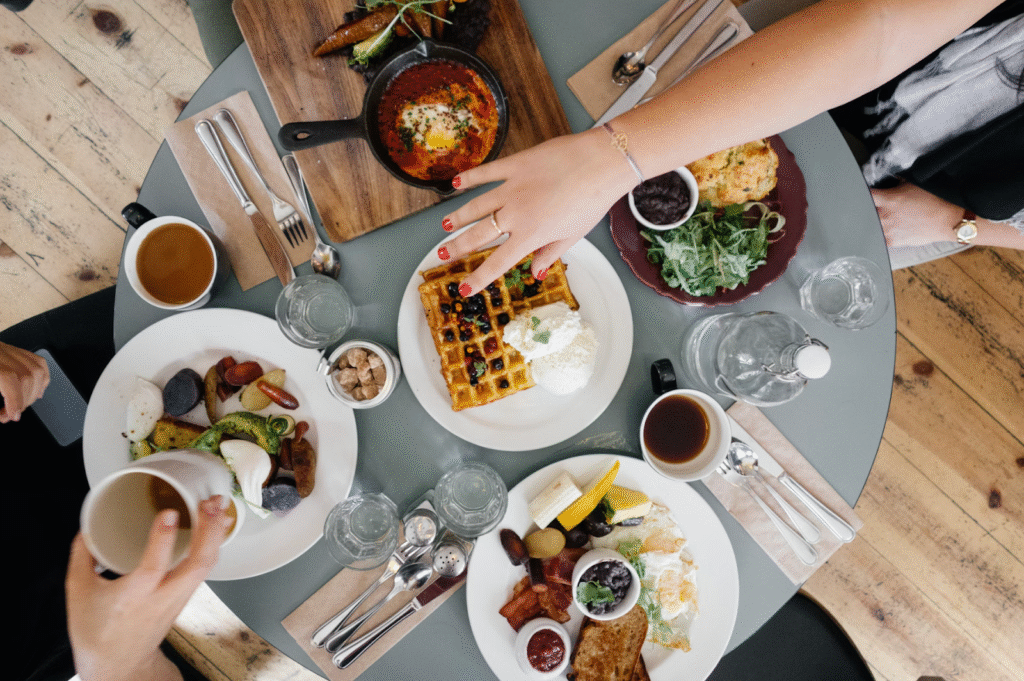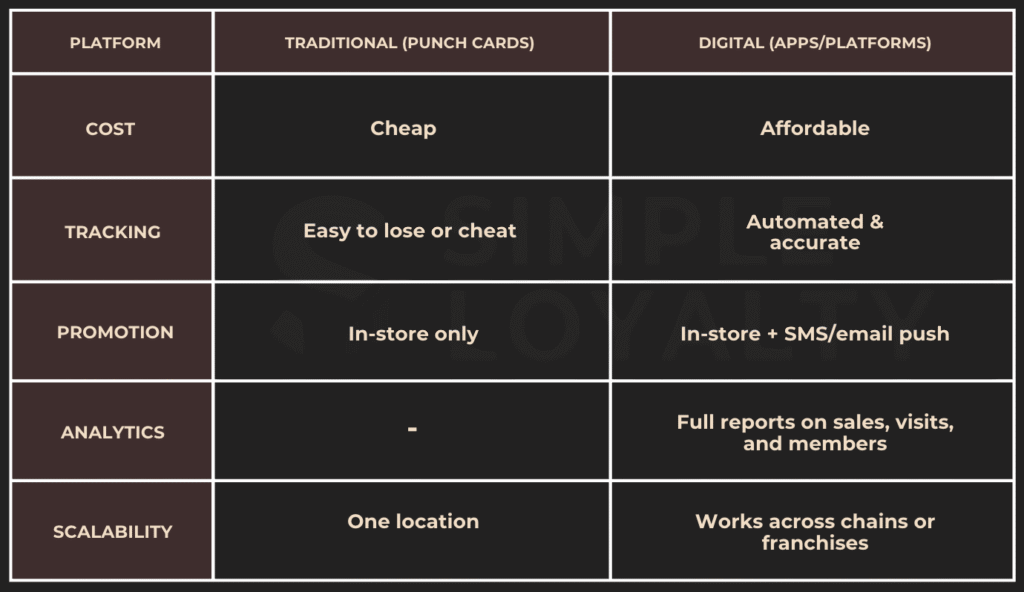Estimated Reading Time: 7 minutes

The restaurant down the street serves horrible food. And you know it.
But…they run a loyalty program.
That’s why their tables are full.
Every customer who leaves without joining your loyalty program takes three visits and three sales with them. And possibly forever.
That’s the reality most restaurants don’t want to admit. Food alone doesn’t necessarily guarantee repeat business anymore. Diners have endless options, and even your “regulars” can drift if someone else offers them points, perks, or a free drink on their birthday.
Customers who join a restaurant’s loyalty program visit about 20% more often and spend 20% more per visit compared to those who don’t. In other words, the bigger your loyalty member base, the larger the impact on your top line.
That’s why restaurant loyalty programs are no longer just an option for your restaurant. They’re your sales engine.
- Why Restaurant Loyalty Programs Drive Repeat Visits
- Loyalty Program Ideas That Actually Boost Revenue
- Common Mistakes That Kill Loyalty Program Results
- How to Launch a Loyalty Program for Restaurants
- Digital vs Traditional Loyalty Programs
- Measuring Success: How to Know Your Loyalty Program is Working
- Recap
Why Restaurant Loyalty Programs Drive Repeat Visits
People are predictable. We like free stuff, feeling special, and the illusion that our tenth burger is somehow “earned”.
A strong restaurant loyalty program taps into three psychological levers:
- Reward-driven behavior
Customers chase rewards the way kids chase ice cream trucks.
- Habit creation
The more often someone redeems, the more likely they are to make your restaurant their go-to.
- Exclusivity
Members-only perks make customers feel like VIPs (even if the perk is just a free coffee).
So yes, loyalty programs for restaurants are less about “points” and more about building rituals around your restaurant.
Numbers don’t lie, and neither do your empty tables. Here’s what happens when you launch a smart loyalty rewards program for restaurants:
- Higher visit frequency: Members come back around 20% more often.
- Bigger spend per visit: They also tend to spend 20% more per bill, especially when rewards are tiered.
- Faster reactivation: Dormant customers can be pulled back with simple offers like “50 bonus points if you visit this week”.
According to Deloitte, 57% of diners say loyalty programs influence where they choose to eat. In other words, more than half of your potential customers are literally telling you: “Offer me points or perks, and I’ll pick you over the restaurant next door”.
Stating the obvious, that’s huge. If 100 walk-ins are deciding where to dine this week, you could be winning (or losing) 57 of them purely based on whether you have a loyalty program.
Think of loyalty programs as your restaurant’s unofficial “subscription model”. Instead of paying monthly, customers pay you in repeat visits.
Example:
A regional casual dining restaurant saw member visits increase by 22% within 90 days of launch. Starbucks reported similar patterns, where loyalty members drive over 50% of its U.S. revenue. This proves how powerful repeat customers are to growth.
Loyalty Program Ideas That Actually Boost Revenue
Not all loyalty programs are created equal. A stamp card might work for a corner coffee shop, but a sit-down restaurant needs more thought.
The classics still work: points for purchases and tiered rewards (Bronze, Silver, Gold) remain the backbone of many programs. A little gamification goes a long way. Customers love watching themselves “level up”.
But emotional rewards matter too. Birthday treats never go out of style because people remember the restaurant that gave them free cake on their special day. And sprinkling in the occasional surprise bonus (like double points on a slow Tuesday) keeps members on their toes.
Some restaurants also add referral rewards, but only when they’re simple. The golden rule is if your program makes customers pull out a calculator, consider them lost.
Case in point:
A QSR (Quick Service Restaurant) client saw a 30% lift in weekday sales after introducing “double points Tuesdays”. This type of reward builds loyalty far beyond boring discounts.
Common Mistakes That Kill Loyalty Program Results
Some restaurant launch loyalty programs with fireworks… only to see them fizzle out.
The first mistake?
Complexity. Customers shouldn’t feel like they need to do algebra for a taco. Keep it stupid simple.
Another common issue is invisibility. If your staff fails to promote your restaurant loyalty program, customers won’t remember it exists.
And then there are weak rewards. A “free napkin after five visits” won’t inspire anyone. Your perks have to feel meaningful.
Finally, too many restaurants forget the follow-up. Without SMS or email nudges, your loyalty program fades into the background. Out of sight, out of mind.
Example:
One of our other clients launched a “Buy 9 Get 1 Free” card but saw less than 15% redemption because staff rarely promoted it. After switching to a digital loyalty program with automated SMS nudges, sign-ups tripled and redemption rates jumped above 40%.
So remember, a loyalty program is a system. And like any system, it only works if people actually use it.
How to Launch a Loyalty Program for Restaurants
Starting a loyalty program isn’t rocket science. But it’s also not something you want to wing over a weekend with a box of punch cards. The best loyalty programs are simple, intentional, and easy to adopt for both customers and staff.
Here’s the playbook:
- Understand your audience
What excites your customers? Is it the free fries or exclusive deals? Survey or casually ask them. You’d be surprised how often “one free coffee a week” beats complicated point formulas.
- Define your goal
Is it higher visit frequency, upselling, or collecting customer data for better marketing? Your goal shapes your rewards.
- Choose the right format
- Cafes and QSRs (Quick-Service Restaurants) often thrive with points or stamp-style rewards.
- Full-service restaurants may do better with tiered perks (Bronze → Silver → Gold).
- Subscription-style loyalty can turn casual guests into near-daily visitors.
- Pick your platform
Ditch the spreadsheets. A loyalty platform like SimpleLoyalty lets you track sign-ups, redemptions, and customer value automatically. So you can focus on serving food, not counting punches.
- Train your staff
Your team is your frontline. If they don’t actively mention and promote the program, customers won’t know it exists. Make staff enrollment incentives part of your launch.
- Promote everywhere
Menus, tables, receipts, and on social media platforms. If customers don’t see it, they won’t join. Visibility is half the battle.
- Keep it simple
If customers need to manually calculate how many tacos until a free taco, you’ve lost them. Stick with rewards they can grasp in 3 seconds flat.
- Track results
Launching is just the start. Measure enrollment, redemptions, and spend lift. If something’s flat, tweak the reward.
Pro Tip
Launch with a small “Founding Members” perk, like a free dessert for the first 100 sign-ups. That early buzz builds momentum and gives you social proof to expand.
Digital vs Traditional Loyalty Programs
Restaurants today face a fork in the road: stick with old-school punch cards or move digital.
Here’s the breakdown:

Traditional loyalty cards are cheap and quick to start. They work for ultra-small businesses or one-off campaigns, but they come with headaches. Cards get lost, staff forget to stamp, and you capture zero data.
Digital loyalty programs, on the other hand, give you:
- Higher engagement
Customers are less likely to forget about your program because it lives on their phones. Push notifications, SMS reminders, and in-app promotions keep your restaurant top-of-mind, driving customers back in more often than a forgotten paper card ever could.
- Data-driven insights
With digital, every transaction tells a story. You’ll know who your best customers are, what they order most, and when they’re likely to return. This lets you create smarter offers, like sending a personalized discount right before a customer’s usual visit time.
- Flexibility
Paper punch cards can’t adapt, but digital platforms can. You can switch rewards, run limited-time promotions, or test different incentives without reprinting everything. That flexibility makes your loyalty program easy to optimize and scale as your restaurant grows.
Bottom line: Traditional works for simplicity, but digital loyalty programs for restaurants win on engagement, reach, and data. That’s why so many restaurants are making the switch from physical punch cards to digital-first loyalty systems.
Many restaurants are already making the switch. Explore digital loyalty cards and see how fast you can get started.
Measuring Success: How to Know Your Loyalty Program is Working
Launching a loyalty program is step one. Step two is making sure it’s actually growing your sales.
Track these key metrics:
- Enrollment rate: How many guests are signing up?
- Active members: Are people redeeming, or just collecting digital dust?
- Visit frequency: Are members visiting more often than non-members?
- Spend per visit: Is the average bill going up?
- Redemption rate: If no one uses rewards, the program isn’t sticky enough.
If you’re not seeing movement in at least two of these areas, it’s time to adjust your program design or communication.
Recap
Here’s the uncomfortable truth: your food might be out of this world, but without a loyalty program, you’re competing solely based on luck. Restaurants with loyalty programs don’t just keep customers. They grow sales with every visit.
The math is super simple:
More members = more visits = more revenue.
So the question isn’t “Should I start a loyalty program?”. It’s “How many sales are you losing by not having one already?”
The easiest place to start? A platform built for restaurants and retail businesses. That’s why so many small businesses are switching to SimpleLoyalty. The best plug-and-play solution that takes the guesswork (and the headache) out of running a loyalty program.
Because the future of your restaurant isn’t just about great food. It’s keeping customers coming back for seconds, thirds, and beyond.

